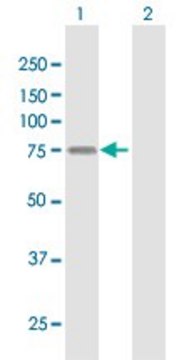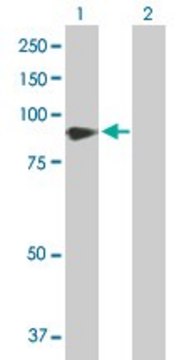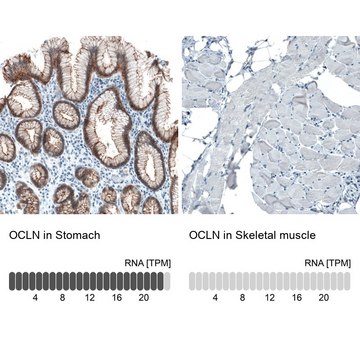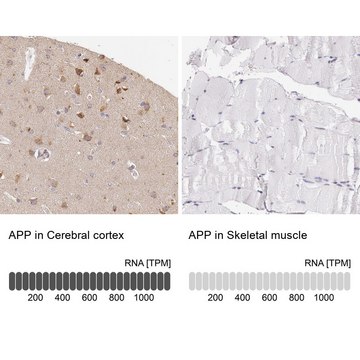SAB1406198
Anti-OCLN antibody produced in mouse
purified immunoglobulin, buffered aqueous solution
Sign Into View Organizational & Contract Pricing
All Photos(1)
About This Item
UNSPSC Code:
12352203
NACRES:
NA.41
Recommended Products
biological source
mouse
Quality Level
conjugate
unconjugated
antibody form
purified immunoglobulin
antibody product type
primary antibodies
clone
polyclonal
form
buffered aqueous solution
mol wt
antigen ~59.1 kDa
species reactivity
human
technique(s)
western blot: 1 μg/mL
NCBI accession no.
UniProt accession no.
shipped in
dry ice
storage temp.
−20°C
target post-translational modification
unmodified
Gene Information
human ... OCLN(4950)
General description
This gene encodes an integral membrane protein which is located at tight junctions. This protein may be involved in the formation and maintenance of the tight junction. The possibility of several alternatively spliced products has been suggested but the full nature of these products has not been described. (provided by RefSeq)
Immunogen
OCLN (NP_002529.1, 1 a.a. ~ 522 a.a) full-length human protein.
Sequence
MSSRPLESPPPYRPDEFKPNHYAPSNDIYGGEMHVRPMLSQPAYSFYPEDEILHFYKWTSPPGVIRILSMLIIVMCIAIFACVASTLAWDRGYGTSLLGGSVGYPYGGSGFGSYGSGYGYGYGYGYGYGGYTDPRAAKGFMLAMAAFCFIAALVIFVTSVIRSEMSRTRRYYLSVIIVSAILGIMVFIATIVYIMGVNPTAQSSGSLYGSQIYALCNQFYTPAATGLYVDQYLYHYCVVDPQEAIAIVLGFMIIVAFALIIFFAVKTRRKMDRYDKSNILWDKEHIYDEQPPNVEEWVKNVSAGTQDVPSPPSDYVERVDSPMAYSSNGKVNDKRFYPESSYKSTPVPEVVQELPLTSPVDDFRQPRYSSGGNFETPSKRAPAKGRAGRSKRTEQDHYETDYTTGGESCDELEEDWIREYPPITSDQQRQLYKRNFDTGLQEYKSLQSELDEINKELSRLDKELDDYREESEEYMAAADEYNRLKQVKGSADYKSKKNHCKQLKSKLSHIKKMVGDYDRQKT
Sequence
MSSRPLESPPPYRPDEFKPNHYAPSNDIYGGEMHVRPMLSQPAYSFYPEDEILHFYKWTSPPGVIRILSMLIIVMCIAIFACVASTLAWDRGYGTSLLGGSVGYPYGGSGFGSYGSGYGYGYGYGYGYGGYTDPRAAKGFMLAMAAFCFIAALVIFVTSVIRSEMSRTRRYYLSVIIVSAILGIMVFIATIVYIMGVNPTAQSSGSLYGSQIYALCNQFYTPAATGLYVDQYLYHYCVVDPQEAIAIVLGFMIIVAFALIIFFAVKTRRKMDRYDKSNILWDKEHIYDEQPPNVEEWVKNVSAGTQDVPSPPSDYVERVDSPMAYSSNGKVNDKRFYPESSYKSTPVPEVVQELPLTSPVDDFRQPRYSSGGNFETPSKRAPAKGRAGRSKRTEQDHYETDYTTGGESCDELEEDWIREYPPITSDQQRQLYKRNFDTGLQEYKSLQSELDEINKELSRLDKELDDYREESEEYMAAADEYNRLKQVKGSADYKSKKNHCKQLKSKLSHIKKMVGDYDRQKT
Physical form
Solution in phosphate buffered saline, pH 7.4
Not finding the right product?
Try our Product Selector Tool.
recommended
Product No.
Description
Pricing
Storage Class Code
10 - Combustible liquids
WGK
WGK 1
Flash Point(F)
Not applicable
Flash Point(C)
Not applicable
Choose from one of the most recent versions:
Certificates of Analysis (COA)
Lot/Batch Number
Don't see the Right Version?
If you require a particular version, you can look up a specific certificate by the Lot or Batch number.
Already Own This Product?
Find documentation for the products that you have recently purchased in the Document Library.
Mei Chin Lee et al.
Investigative ophthalmology & visual science, 55(6), 3833-3841 (2014-05-08)
The role of the recently identified primary angle closure glaucoma (PACG) susceptibility gene, pleckstrin homology domain containing, family A member 7 (PLEKHA7), in PACG is unknown. PLEKHA7 associates with apical junctional complexes (AJCs) and is thus implicated in paracellular fluid
Yingli Jing et al.
Chinese medical journal, 127(15), 2808-2813 (2014-08-26)
Pericytes, located on microvessels, help to maintain vascular stability and blood-brain barrier integrity. The influence of pericytes on microvessels after spinal cord injury (SCI) is less clear. Therefore, the aim of this study was to investigate whether pericytes took a
Hepatitis C virus (HCV) interaction with astrocytes: nonproductive infection and induction of IL-18.
Ziqing Liu et al.
Journal of neurovirology, 20(3), 278-293 (2014-03-29)
Hepatitis C virus (HCV) infection causes the central nervous system (CNS) abnormalities in more than 50 % of chronically infected subjects. However, the underlying mechanisms are largely unknown. In this study, we characterized the HCV interactions with astrocytes, one of the
Xiaodong Zheng et al.
Investigative ophthalmology & visual science, 55(6), 3454-3460 (2014-05-02)
To compare the efficacy of three types of ocular lubricants in protecting corneal epithelial cells in dry eye animal models. Ocular lubricants containing 0.1% or 0.3% sodium hyaluronate (SH), carboxymethylcellulose (CMC), or hydroxypropyl methylcellulose (HPMC) were tested. First, ocular lubricant
Mylene Nébot-Vivinus et al.
World journal of gastroenterology, 20(22), 6832-6843 (2014-06-20)
To investigate the effect of the probiotic combination Lactibiane Tolerance(®) (LT) on epithelial barrier function in vitro and in vivo. The effect of the multispecies probiotic LT was assessed on several models of epithelial barrier function both in vitro (in
Our team of scientists has experience in all areas of research including Life Science, Material Science, Chemical Synthesis, Chromatography, Analytical and many others.
Contact Technical Service








